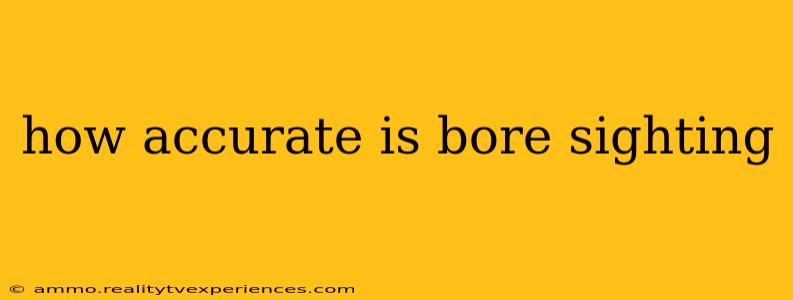Bore sighting, a preliminary step in firearm zeroing, involves aligning the firearm's barrel with the target. But how accurate is it, really? The answer, unfortunately, isn't a simple number. The accuracy of bore sighting depends on several interconnected factors, and understanding these is crucial for any shooter aiming for precision.
Factors Affecting Bore Sighting Accuracy
Several variables influence the accuracy of your bore sight:
1. The Bore Sighting Tool Itself:
The quality of your bore sighting tool significantly impacts the accuracy. A poorly made or improperly calibrated tool will introduce errors from the outset. High-quality bore sighting tools, often using lasers or telescopic attachments, generally offer better accuracy than simpler methods.
2. Technique and User Skill:
Even with the best equipment, improper technique can lead to significant inaccuracies. Precise alignment of the bore sighting tool within the barrel is paramount. A slight misalignment can translate into substantial errors at longer ranges. Experience and careful attention to detail are essential for reliable results.
3. Firearm Condition:
The condition of your firearm directly influences bore sighting accuracy. A firearm with a damaged barrel, loose components, or improperly installed sights will yield less accurate results. Regular maintenance and ensuring your firearm is in proper working order are crucial.
4. Ammunition Variations:
While bore sighting doesn't directly involve ammunition, the type of ammunition used for subsequent zeroing can indirectly influence the perceived accuracy of the bore sight. Variations in bullet weight and ballistic characteristics can affect point of impact, making the initial bore sight seem less accurate than it truly was.
5. Environmental Factors:
External conditions, such as wind and temperature, can slightly affect laser bore sighting accuracy, although these effects are usually minimal compared to other factors. These effects become more pronounced during live fire zeroing.
Bore Sighting: Not a Replacement for Proper Zeroing
It's crucial to understand that bore sighting is not a substitute for proper zeroing. Bore sighting provides a rough approximation of point of impact; it's a starting point, bringing the point of impact closer to the point of aim to reduce the number of shots needed for zeroing. It significantly reduces the time and ammunition needed during live fire zeroing at the range.
Think of bore sighting as a guide, not a precise measurement. Always follow up with live fire zeroing at the range to achieve true accuracy and ensure your firearm is properly sighted for your specific ammunition and range.
Improving Bore Sighting Accuracy
Several strategies can improve the accuracy of your bore sight:
- Invest in a high-quality bore sighting tool: A well-made tool is a worthwhile investment for improved accuracy.
- Practice your technique: Proper alignment is crucial. Take your time and carefully follow the instructions for your specific bore sighting tool.
- Ensure your firearm is clean and well-maintained: A firearm in good working order is essential for accurate results.
- Use consistent ammunition: Using the same type of ammunition during both bore sighting (if a laser is used) and zeroing will help minimize discrepancies.
Conclusion
Bore sighting offers a convenient method for initial alignment, significantly accelerating the zeroing process. However, its accuracy is inherently limited. It's a valuable tool for getting close, but it shouldn't replace the meticulous process of live fire zeroing at the range. By understanding the factors influencing accuracy and employing sound techniques, you can maximize the effectiveness of bore sighting and achieve a more precise zero on your firearm.

